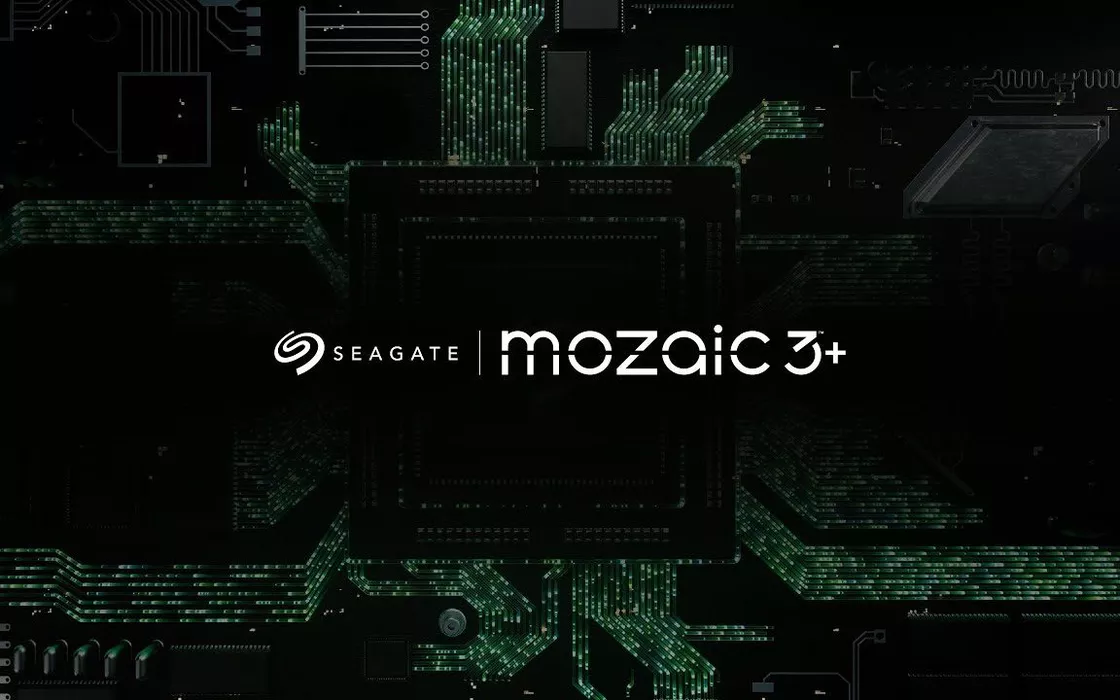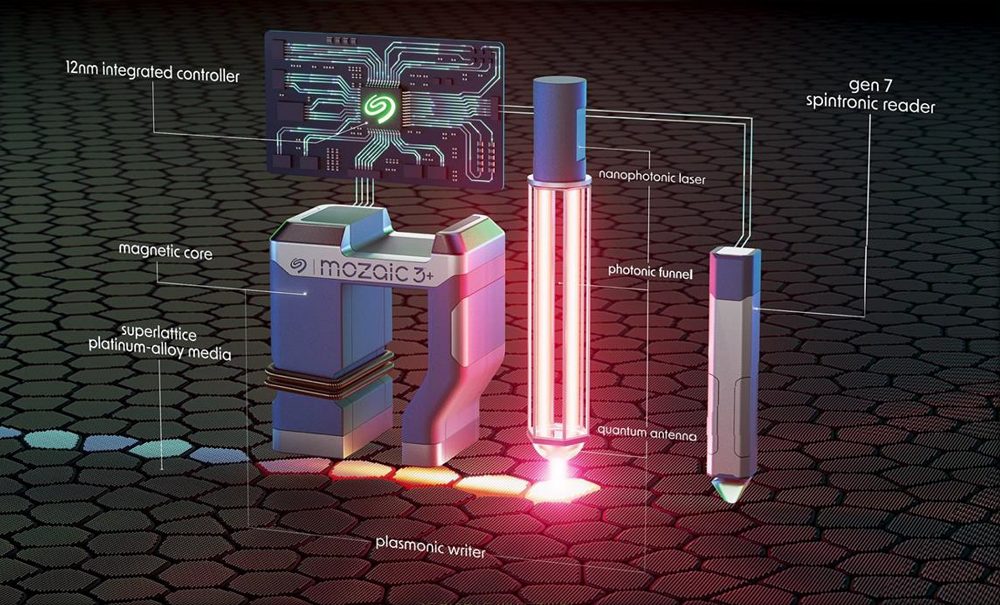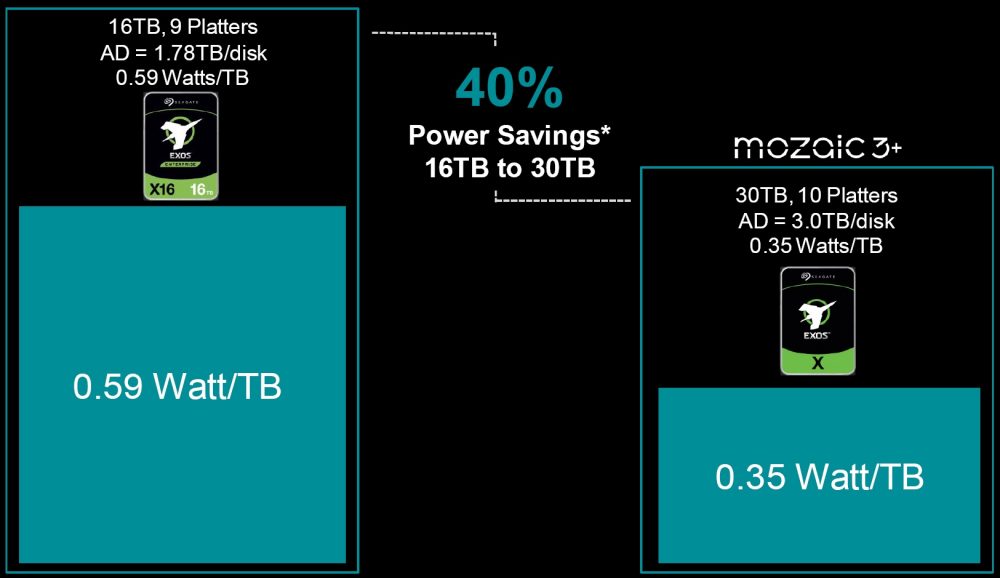For some years now, some analysts have been predicting the short-term shelving of hard disk in favor of the units SSD. In October 2023, Pure Storage hypothesized that by the end of 2028 no hard disks will be sold in the enterprise sector, for uses in the segment data center.
These stances clash with the efforts of the leaders player of the world of storage who are competing to make hard disks increasingly capacious and convenient in terms of cost per gigabyte. At Christmas 2023 Toshiba stated that hard drives are 7 times cheaper than SSDs.
Seagate hits the 30TB storage milestone with Mozaic 3+
To ward off the Cassandras that describe a dark future for traditional hard drives, Seagate shows what – at present – is the largest storage unit available on the market. In reality it is not yet purchasable (it will be from March 2024), but the company is keen to publicize the objective achieved as much as possible.
To increase the data densitySeagate has once again used HAMR technology (Heat-Assisted Magnetic Recording). In the case of hard disk HAMR, a laser temporarily heats a small portion of the hard drive’s surface as information is written. This heating reduces the magnetic coercivity of the material, allowing the magnetic field generated by the writing head to more easily influence the particles on the surface of the platter. The approach allows you to write data with greater precisionin small spaces.
In another article we see the main differences between CMR, SMR, MAMR, HAMR and HDMR hard disks.
Making a hard drive from 30 TB Of capacity it’s just a first step in roadmap by Seagate: the company, in fact, plans to present hard drives of even greater capacity in the near future. Mosaic 3+ it is in fact a new platform that uses innovative technologies in terms of controllers, supports, writing and reading heads.
What you need to know about the Seagate Mozaic 3+ platform
It’s been quite fashionable to say it lately, but Mozaic 3+ wants to be a “future-proof” platform, capable of facing and overcoming the challenges related to information storage. At the moment, as in the case of the hard disk Seagate Exos Mosaic 3+ of 30 TB, the solution uses 10 glass platters with a magnetic layer composed of a structure made of iron-platinum. It gives longevity and allows you to “package” thinner platters than those usually used in common hard disks.
Seagate presents itself as the first and currently only manufacturer capable of offering a capacity of 3 TB per single platter. The CEO Dave Mosley, however, added that the intention is to bring that value to 5TB as well. So much so that the platform should debut by 2026 Mosaic 4+with the following (Mosaic 5+) scheduled for 2028. In one case the hard disks will reach 40 TB of capacity; in the other they will go up to over 50 TB.
The innovative components used for the new HAMR hard drives
Seagate engineers talk about adopting an innovative Plasmonic Writer that is, the component that heats the recording medium to over 420 degrees and then cools it in less than two nanoseconds. The laser nanofotonico creates an extremely small hot spot in the storage area, causing data to be stored on the magnetic media.
The Cupertino (California) company also mentions a Spintronic player seventh generation, a data reading component based on spintronic technologies. There spintronica is an area of physics that exploits the “spin” of electrons (an intrinsic quantum property) to store, transfer and process information. Seagate brand HAMR hard drives use spintronics to improve the efficiency and accuracy of reading data stored on the devices.
Thanks to the technologies adopted by Seagate, Mozaic 3+ hard drives can significantly increase density using practically the same materials as traditional products. In the face of a energy consumption 40% smaller than 16TB PMR drives. Also there amount of carbon per terabyte is drastically reduced, by 55%. PMR stands for “Perpendicular Magnetic Recording“: This is a magnetic recording technology used in hard drives to store data.
Il controller Made with a 12 nm construction process, it is much more powerful than its predecessors: precise interaction with the reading and writing system requires significantly greater computing power. Seagate has not disclosed the number and type of cores that equip the controller: being a strong supporter of RISC-Vthe company may have chosen to use custom cores to manage the operation of its modern HAMR hard drives.
A few words about the performance of Mozaic 3+ hard drives
We’ve already said that the Seagate Mozaic 3+ platform increases capacity while reducing power consumption. The new units also ensure reading and writing speed sequential which promise to be significantly superior. However, even the performance in terms of IOPS are reduced: this requires users, for example cloud service providers, to mitigate this aspect using ancillary technologies.
IOPS (Input/Output Operations Per Second) is a metric used to measure the performance of a storage device and also takes into account 4K random reads and writes to the drive, i.e. the management of small files, spread across various clusters.
HAMR-based Mozaic 3+ storage technology will be brought to a variety of products, including enterprise hard drives, NAS servers, and general imaging and video processing systems. In short, Seagate also plans to put hard drives on the market IronWolf e SkyHawk based in turn on HAMR.
According to estimates, HAMR technology could allow the achievement of capacities equal to at least 80 TB in the future.
The images published in the article are from Seagate.



